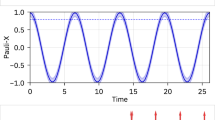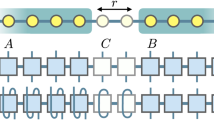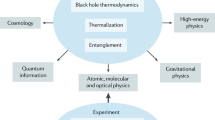Abstract
Scrambling, a process in which quantum information spreads over a complex quantum system, becoming inaccessible to simple probes, occurs in generic chaotic quantum many-body systems, ranging from spin chains to metals and even to black holes. Scrambling can be measured using out-of-time-ordered correlators (OTOCs), which are closely tied to the growth of Heisenberg operators. We present a general method to calculate OTOCs of local operators in one-dimensional systems based on approximating Heisenberg operators as matrix product operators (MPOs). Contrary to the common belief that such tensor network methods work only at early times, we show that the entire early growth region of the OTOC can be captured using an MPO approximation with modest bond dimension. We analytically establish the goodness of the approximation by showing that, if an appropriate OTOC is close to its initial value, then the associated Heisenberg operator has low entanglement across a given cut. We use the method to study scrambling in a chaotic spin chain with \(201\) sites. On the basis of these data and previous results, we conjecture a universal form for the dynamics of the OTOC near the wavefront. We show that this form collapses the chaotic spin chain data over more than 15 orders of magnitude.
This is a preview of subscription content, access via your institution
Access options
Access Nature and 54 other Nature Portfolio journals
Get Nature+, our best-value online-access subscription
$29.99 / 30 days
cancel any time
Subscribe to this journal
Receive 12 print issues and online access
$209.00 per year
only $17.42 per issue
Buy this article
- Purchase on Springer Link
- Instant access to full article PDF
Prices may be subject to local taxes which are calculated during checkout




Similar content being viewed by others
Data availability
The data that support the plots within this paper and other findings of this study are available from the corresponding author on reasonable request.
Code availability
The code used to perform the numerical simulation within this paper is available from the corresponding author on reasonable request.
References
Hayden, P. & Preskill, J. Black holes as mirrors: quantum information in random subsystems. J. High Energy Phys. 2007, 120 (2007).
Sekino, Y. & Susskind, L. Fast scramblers. J. High Energy Phys. 2008, 065 (2008).
Shenker, S. H. & Stanford, D. Black holes and the butterfly effect. J. High Energy Phys. 2014, 67 (2014).
Hosur, P., Qi, X.-L., Roberts, D. A. & Yoshida, B. Chaos in quantum channels. J. High Energy Phys. 2016, 4 (2016).
Deutsch, J. M. Quantum statistical mechanics in a closed system. Phys. Rev. A 43, 2046–2049 (1991).
Srednicki, M. Chaos and quantum thermalization. Phys. Rev. E 50, 888–901 (1994).
Tasaki, H. From quantum dynamics to the canonical distribution: general picture and a rigorous example. Phys. Rev. Lett. 80, 1373–1376 (1998).
Rigol, M., Dunjko, V. & Olshanii, M. Thermalization and its mechanism for generic isolated quantum systems. Nature 452, 854–858 (2008).
Sachdev, S. & Ye, J. Gapless spin-fluid ground state in a random quantum Heisenberg magnet. Phys. Rev. Lett. 70, 3339–3342 (1993).
Kitaev, A. A simple model of quantum holography. In KITP Program: Entanglement in Strongly-Correlated Quantum Matter http://online.kitp.ucsb.edu/online/entangled15/kitaev/ (2015).
Gu, Y., Qi, X.-L. & Stanford, D. Local criticality, diffusion and chaos in generalized Sachdev–Ye–Kitaev models. J. High Energy Phys. 2017, 125 (2017).
Maldacena, J., Shenker, S. H. & Stanford, D. A bound on chaos. J. High Energy Phys. 2016, 106 (2016).
Swingle, B. & Chowdhury, D. Slow scrambling in disordered quantum systems. Phys. Rev. B 95, 060201 (2017).
Chen, Y. Universal logarithmic scrambling in many body localization. Preprint at https://arxiv.org/abs/1608.02765 (2016).
Fan, R., Zhang, P., Shen, H. & Zhai, H. Out-of-time-order correlation for many-body localization. Sci. Bull. 62, 707–711 (2017).
Huang, Y., Zhang, Y.-L. & Chen, X. Out-of-time-ordered correlators in many-body localized systems. Ann. Phys. 529, 1600318 (2017).
Swingle, B., Bentsen, G., Schleier-Smith, M. & Hayden, P. Measuring the scrambling of quantum information. Phys. Rev. A 94, 040302 (2016).
Zhu, G., Hafezi, M. & Grover, T. Measurement of many-body chaos using a quantum clock. Phys. Rev. A 94, 062329 (2016).
Yao, N.Y. et al. Interferometric approach to probing fast scrambling. Preprint at https://arxiv.org/abs/1607.01801 (2016).
Yunger Halpern, N. Jarzynski-like equality for the out-of-time-ordered correlator. Phys. Rev. A 95, 012120 (2017).
Yunger Halpern, N., Swingle, B. & Dressel, J. Quasiprobability behind the out-of-time-ordered correlator. Phys. Rev. A 97, 042105 (2018).
Campisi, M. & Goold, J. Thermodynamics of quantum information scrambling. Phys. Rev. E 95, 062127 (2017).
Yoshida, B. & Kitaev, A. Efficient decoding for the Hayden-Preskill protocol. Preprint at https://arxiv.org/abs/1710.03363 (2017).
Garttner, M. et al. Measuring out-of-time-order correlations and multiple quantum spectra in a trapped-ion quantum magnet. Nat. Phys. 13, 781–786 (2017).
Wei, K. X., Ramanathan, C. & Cappellaro, P. Exploring localization in nuclear spin chains. Phys. Rev. Lett. 120, 070501 (2018).
Li, J. et al. Measuring out-of-time-order correlators on a nuclear magnetic resonance quantum simulator. Phys. Rev. X 7, 031011 (2017).
Meier, E. J., Ang’ong’a, J., An, F. A. & Gadway, B. Exploring quantum signatures of chaos on a Floquet synthetic lattice. Phys. Rev. A 100, 013623 (2019).
Leviatan, E., Pollmann, F., Bardarson, J. H., Huse, D. A. & Altman, E. Quantum thermalization dynamics with matrix-product states. Preprint at https://arxiv.org/abs/1702.08894 (2017).
Chen, X., Zhou, T. & Xu, C. Measuring the distance between quantum many-body wave functions. J. Stat. Mech. Theory Exp. 2018, 073101 (2018).
Bordia, P., Alet, F. & Hosur, P. Out-of-time-ordered measurements as a probe of quantum dynamics. Phys. Rev. A 97, 030103 (2018).
Roberts, D. A. & Stanford, D. Diagnosing chaos using four-point functions in two-dimensional conformal field theory. Phys. Rev. Lett. 115, 131603 (2015).
Stanford, D. Many-body chaos at weak coupling. J. High Energy Phys. 2016, 9 (2016).
Chowdhury, D. & Swingle, B. Onset of many-body chaos in the \(O(N)\) model. Phys. Rev. D 96, 065005 (2017).
Patel, A. A., Chowdhury, D., Sachdev, S. & Swingle, B. Quantum butterfly effect in weakly interacting diffusive metals. Phys. Rev. X 7, 031047 (2017).
Nahum, A., Ruhman, J. & Huse, D. A. Dynamics of entanglement and transport in one-dimensional systems with quenched randomness. Phys. Rev. B 98, 035118 (2018).
Nahum, A., Vijay, S. & Haah, J. Operator spreading in random unitary circuits. Phys. Rev. X 8, 021014 (2018).
Khemani, V., Vishwanath, A. & Huse, D. A. Operator spreading and the emergence of dissipative hydrodynamics under unitary evolution with conservation laws. Phys. Rev. X 8, 031057 (2018).
Rakovszky, T., Pollmann, F. & vonKeyserlingk, C. W. Diffusive hydrodynamics of out-of-time-ordered correlators with charge conservation. Phys. Rev. X 8, 031058 (2018).
Luitz, D. J. & BarLev, Y. Information propagation in isolated quantum systems. Phys. Rev. B 96, 020406 (2017).
Bohrdt, A., Mendl, C. B., Endres, M. & Knap, M. Scrambling and thermalization in a diffusive quantum many-body system. New J. Phys. 19, 063001 (2016).
Heyl, M., Pollmann, F. & Dóra, B. Detecting equilibrium and dynamical quantum phase transitions in Ising chains via out-of-time-ordered correlators. Phys. Rev. Lett. 121, 016801 (2018).
Lin, C.-J. & Motrunich, O. I. Out-of-time-ordered correlators in a quantum Ising chain. Phys. Rev. B 97, 144304 (2018).
Vidal, G. Classical simulation of infinite-size quantum lattice systems in one spatial dimension. Phys. Rev. Lett. 98, 70201 (2007).
White, C. D., Zaletel, M., Mong, R. S. K. & Refael, G. Quantum dynamics of thermalizing systems. Phys. Rev. B 97, 035127 (2018).
Song, X. Y., Jian, C. M. & Balents, L. Strongly correlated metal built from Sachdev–Ye–Kitaev models. Phys. Rev. Lett. 119, 216601 (2017).
Ben-Zion, D. & McGreevy, J. Strange metal from local quantum chaos. Phys. Rev. B 97, 155117 (2018).
Lieb, E. H. & Robinson, D. W. The finite group velocity of quantum spin systems. Commun. Math. Phys. 28, 251–257 (1972).
Nachtergaele, B. & Sims, R. Lieb–Robinson bounds in quantum many-body physics. In Entropy and the Quantum (eds R. Sims & D. Ueltschi) Contemporary Mathematics Vol. 529, 141–176 (American Mathematical Society, 2010).
Gopalakrishnan, S., Huse, D. A., Khemani, V. & Vasseur, R. Hydrodynamics of operator spreading and quasiparticle diffusion in interacting integrable systems. Phys. Rev. B 98, 220303 (2018).
Acknowledgements
We thank J. Garrison, D. Roberts, A. Kitaev and D. Stanford for interesting discussions. This material is based on work supported by the Simons Foundation via the It from Qubit Collaboration, by the Air Force Office of Scientific Research under award number FA9550-17-1-0180 and by the NSF Physics Frontier Center at the Joint Quantum Institute (PHY-1430094).
Author information
Authors and Affiliations
Contributions
S.X. and B.S. initiated the study. S.X. developed the computational tool and performed the numerical simulations. S.X. and B.S. analysed the results and wrote the manuscript.
Corresponding author
Ethics declarations
Competing interests
The authors declare no competing interests.
Additional information
Peer review information Nature Physics thanks Beni Yoshida and the other, anonymous, reviewer(s) for their contribution to the peer review of this work.
Publisher’s note Springer Nature remains neutral with regard to jurisdictional claims in published maps and institutional affiliations.
Supplementary information
Rights and permissions
About this article
Cite this article
Xu, S., Swingle, B. Accessing scrambling using matrix product operators. Nat. Phys. 16, 199–204 (2020). https://doi.org/10.1038/s41567-019-0712-4
Received:
Accepted:
Published:
Issue Date:
DOI: https://doi.org/10.1038/s41567-019-0712-4
This article is cited by
-
Many-body quantum chaos in stroboscopically-driven cold atoms
Communications Physics (2023)
-
Exploiting disorder to probe spin and energy hydrodynamics
Nature Physics (2023)
-
Barren plateaus from learning scramblers with local cost functions
Journal of High Energy Physics (2023)
-
Charge transport, information scrambling and quantum operator-coherence in a many-body system with U(1) symmetry
Journal of High Energy Physics (2023)
-
Operator growth and Krylov complexity in Bose-Hubbard model
Journal of High Energy Physics (2023)



